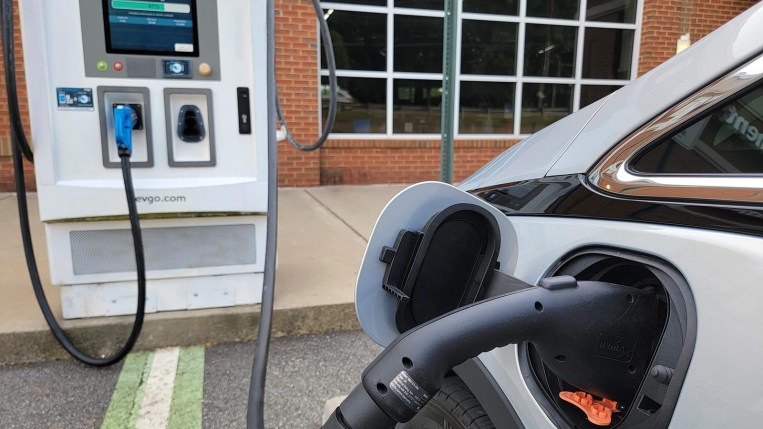[ad_1]

My initial experience charging an electric vehicle at public stations was eye-opening. I had previously heard, read, and written about charging stations, different types of chargers, and other information about EV charging. Still, there often is a learning curve when trying something new with your own hands in the real world.
Read on to learn what I experienced when I used electric car charging stations for the first time.
Finding EV Charger Locations
The U.S. Department of Energy says that more than 80% of EV owners charge at home. Some employers provide chargers at company parking lots. And a growing number of public chargers are available for EV drivers when they’re out and about running errands or when traveling away from home.
A few charging locations are close to my neighborhood in the Atlanta suburbs. I knew of chargers in a couple of nearby shopping center parking lots. And a long time ago, I read that my electricity provider offers public chargers at its office.
Before I picked up a 2022 Chevrolet Bolt EV to test drive, I checked the searchable map of almost 48,000 U.S. station locations on the DOE’s Alternative Fuels Data Center website. It turns out that there are more charging options near me than I knew of — and there are other apps to locate them.
Free Level 2 Charging Can Be Good
My first charging stop was in a parking lot at a shopping center with a grocery store and other storefronts. It offers two Level 2 charging units that are free to use, and both were available when I pulled into a parking spot.
Level 2 chargers offer the same voltage (220- to 240-volt) as a typical residential electric clothes dryer. The chargers charge at about 6 kilowatts (kW), adding about 20-25 miles of range per hour to the Bolt.
The charging cord felt heavier than a gas pump hose. The connecter type was the common J1772 type. I opened the Bolt’s charging port door on the left front panel and snapped the connecter into place. It wasn’t difficult, but the cord is more rigid than a gas hose, so my first try wasn’t as smooth as wielding a gas pump nozzle. The charging station’s digital screen said it was working, as did the car’s information display. So, I went into the grocery store to buy a couple of things.
My quick shopping trip took about 15 minutes. The car’s lithium-ion battery gained 5 miles of range while I shopped inside the store.
Free Level 3 Charging is Great

My next charging session was at a Level 3 charger. These fast chargers (DC fast chargers, or DCFC) offer between 400 volts to 900 volts and charge at 50 kW or more. Many variables affect charging speeds. Chevy claims the Bolt will gain up to 100 miles in 30 minutes. using a Level 3 DC fast charger.
This station I visited sits on the property of my electricity provider. It uses a system of solar panels arranged like flower petals to generate power for the EV charger. Visitors to the solar flower garden can charge their electric cars for free.
The Bolt’s battery received 11.7 kWh to reach the recommended 80% capacity. The charge added 35 miles to the range in 25 minutes of fast charging — with no fee. If I had brought lunch with me, I could have enjoyed the well-maintained picnic area next to the solar flowers while I waited.
Important EV Charging Lessons Learned
Here are some good lessons from an experienced electric car driver at this charging station. His assumption that this was my first time charging an EV wasn’t too far off. He figured I was a charging newbie because I was standing by the charger and fiddling with my phone to install an app.
EV Charging Apps
I previously had the incorrect impression that EV charging apps were for regular chargers, like the customer loyalty programs used by many retailers. That’s not the case. Instead, different networks maintain charging stations — akin to gas stations of the same brand.
The Nissan Leaf driver who pulled up to the station shortly after I arrived said the apps are necessary for payment and not for earning perks. ChargePoint, EVgo, and Electrify America are just a few of the major networks in the EV charging space. These companies’ apps allow their users to wirelessly pay for the energy they receive from the charging stations.
Even if there isn’t a fee, as is the case at my power company, apps are often needed to initialize the charging session. Now I have four EV charging apps installed on my phone so I can, at least in theory, use most of the charging stations in my region. The grocery store station where I had my first EV charging experience wasn’t networked, so no app or registration was needed.
Charging Dos and Don’ts
The enthusiastic EV driver at the solar flower garden charger shared some other insights. He briefed me on charging etiquette — use common sense, be friendly, and don’t leave your car in a charging spot longer than you need to.
He also warned me about being “ICEd.” The slang term describes the situation where a car with an internal combustion engine uses the parking space designated for EV charging.
Fast Charging for a Fee

I stopped at a different station the next day to try fee-based fast charging using another network. This charging session delivered 11.1 kWh in 21 minutes, costing $6.63. The range added was 23 miles. The location was convenient. A coffee shop, pizza, fast food, ice cream, and a book store were available with a short walk through a parking lot.
Read Related Electric Vehicle Stories:
[ad_2]
Source link
